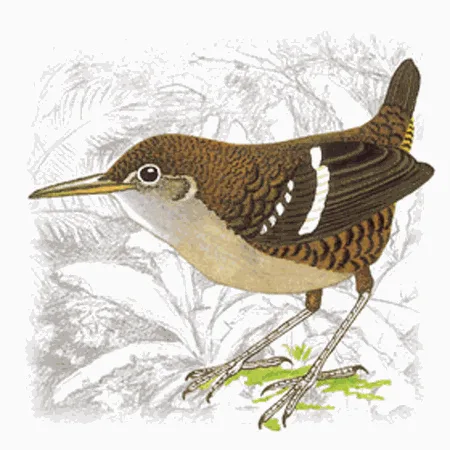
Wing-banded Wren
[order] Passeriformes | [family] Troglodytidae | [latin] Microcerculus bambla | [UK] Wing-banded Wren | [FR] Troglodyte bambla | [DE] Weissbinden-Zaunkonig | [ES] Ratona Bandeada | [IT] Scricciolo di Bambla | [NL] Witband-winterkoning
Subspecies
| Genus | Species | subspecies | Breeding Range | Breeding Range 2 | Non Breeding Range |
| Cyphorhinus | bambla | ||||
| Microcerculus | bambla | SA | n, w Amazonia | ||
| Microcerculus | bambla | albigularis | |||
| Microcerculus | bambla | bambla | |||
| Microcerculus | bambla | caurensis |
Physical charateristics
Dark brown wren with a conspicuous white wing bar. Sides of the head grey and wings and short tail black. Underparts grey with the throat and chine almost white. The feathers are barred giving it a scaled look. Sexes are alike, bill is black. While running the ground it appears to be a very small rail.
Listen to the sound of Wing-banded Wren
[audio:http://www.aviflevoland.nl/sounddb/W/Wing-banded Wren.mp3]
Copyright remark: Most sounds derived from xeno-canto
| wingspan min.: | 0 | cm | wingspan max.: | 0 | cm |
| size min.: | 11 | cm | size max.: | 12 | cm |
| incubation min.: | 0 | days | incubation max.: | 0 | days |
| fledging min.: | 0 | days | fledging max.: | 0 | days |
| broods: | 0 | eggs min.: | 0 | ||
| eggs max.: | 0 |
Range
is found in Brazil, Ecuador, French Guiana, Guyana, Peru, Suriname, and Venezuela.
Habitat
Its natural habitat is subtropical or tropical moist lowland forests.
Reproduction
We describe for the first time the nests of the Wing-banded Wren (Microcerculus bambla),Nests are built in abandoned termite mounds attached to the undersides of fallen trees. The chamber of the nest is lined with a mat of dead leaf fragments. Clutch size probably 1-3 eggs. In one study both nests contained one nestling that disappeared, possibly due to fledging, within a few days of nest discovery. The nests are probably excavated by Puffbirds (Bucconidae) or Jacamars (Galhulidae), so the Wing-banded Wren, apparently are secondary cavity nesters. No data on incubation or fledging period available.
Feeding habits
Forages in dense rainforeast for insects on the ground. Runs (no hopping) catching insects with its short tail always cocked. It specializes in hunting in or around rotten logs and fallen branches. Will sometimes join mixed species flocks.
Conservation
This species has a large range, with an estimated global extent of occurrence of 1,600,000 km
